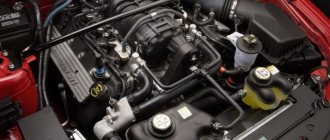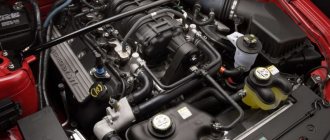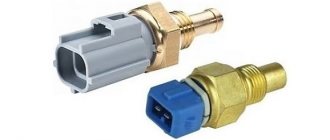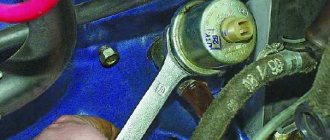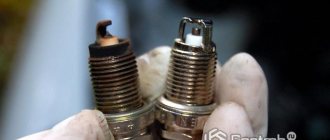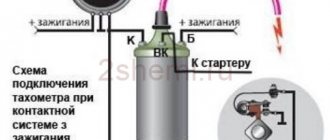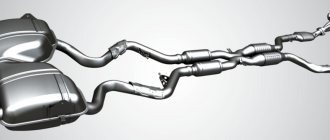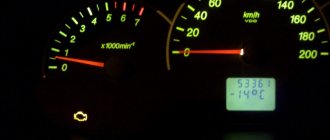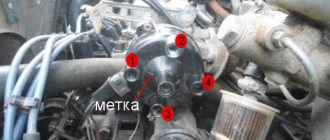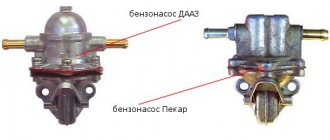Published: 01/28/2021
- Introduction to the topic
- Checking the pump's functionality
- The dangers of losing weight quickly
- injector and carburetor - Auto-Self.ru
- For what reasons does gasoline not flow into the carburetor?
- Post navigation
- Video - car won't start
- What does Gepatrombin ointment (suppositories) help with? Instructions, prices and reviews
- Repair of diesel engine power supply system
- Checking and adjusting the carburetor
- Gabapentin tablets: instructions, reviews, analogues and prices
- For what reasons is fuel not supplied to the cylinders?
- Why isn't fuel getting into the carburetor? Main causes and methods of troubleshooting
- Reasons leading to engine oil foaming
- Electroneuromyography (ENMG) what is it and how is it performed?
- Why is fuel not getting into the cylinders? 4 reasons
Checking the pump's functionality
After this, you should check whether the pump is supplying gasoline. To do this, just unscrew the clamp securing the supply pipe from the fuel pump to the carburetor, lower the end of the pipeline into a container and make sure that the pump pumps. Some fuel pumps have manual pumping, so checking is easy.
But there are also pumps that do not have this function. In this case, you will have to check the operation of the unit with a starter (when the crankshaft rotates, the starter also activates the pump). If uniform streams of gasoline come out of the pipe, in which no air bubbles are visible, then this is an indicator of the serviceability of the gasoline pump, as well as the fuel lines leading to him. And this already narrows the circle of searches, since problems that arise in the area from the tank to the pump are eliminated.
Urinary retention in men, types of pathology
Ishuria is a disease that can develop at different rates. As a rule, depending on this symptom, pathology is divided into two main types
Acute form
As a rule, acute urinary retention in men is quite unexpected for a man. At the same time, he experiences a number of symptoms that accompany the disease. Such signs include pain in the lower abdomen and the urge to go to the toilet more often than usual.
In addition, a man may experience an unpleasant feeling that the bladder is not completely emptied. At the beginning of the development of the disease, the patient’s urine is released in small portions, however, over time, even with stress, urine ceases to be released at all. In this case, urine accumulates in the bladder, causing an enlargement of the man’s abdomen, which becomes very noticeable externally. This condition is dangerous for the body, and therefore it is necessary to urgently consult a doctor.
.
Chronic form
The chronic form, in which a man has difficulty passing urine, usually lasts for a long time. In this case, a man may not notice signs of the disease and not pay attention to the difficulties that arise when urinating. However, sooner or later the urinary canals will narrow so much that it will begin to cause some discomfort to the man. Chronic urinary retention in men can become acute under the influence of external factors.
.
Incomplete urinary retention allows a man to not notice the problem at all for a long time. With the full form of the pathology, a man feels a sharp deterioration in his health, and therefore, as a rule, urgently seeks medical help. In such cases, when a man cannot remove urine on his own, the doctor uses a catheter.
The development of ischuria can be determined by a characteristic sign - the need to strain to go to the toilet. In this case, urination often occurs intermittently. Sometimes men experience so-called paradoxical ischuria, in which the patient is unable to empty the bladder voluntarily, but drops of urine are involuntarily released from the urethra. In any case, the pathology requires medical intervention, and therefore it is highly not recommended to delay with the problem.
injector and carburetor - Auto-Self.ru
Let's start with the fact that during the operation of the car, drivers quite often encounter the fact that the engine does not start, runs intermittently, or suddenly stalls. In this case, diagnostics usually affect the ignition system (on gasoline cars) and the power system.
As practice shows, unstable operation of the power unit on gasoline cars is in many cases due to the fact that gasoline is not supplied to the engine. In this article we will talk about why this happens, as well as what the driver should do if there is no gasoline entering the engine.
For what reasons is fuel not supplied to the cylinders?
So, the general scheme of operation of the power system involves taking fuel from the gas tank, after which the fuel enters the carburetor or injector.
Next, the fuel is supplied to the intake manifold, then the fuel-air mixture enters the combustion chamber through the intake valves.
It becomes clear that if gasoline does not flow into the engine, then this problem occurs both on engines with a carburetor and on injection internal combustion engines. The simplest reason can be considered a lack of gasoline in the tank or damage to the fuel lines. In other words, we are talking about leaks as a result of any damage to the tank or fuel lines, when gasoline leaks out before it gets into the cylinders.
Common problems with the supply of gasoline to the internal combustion engine
If we exclude leaks, the next reason why gasoline is not supplied to the engine is various problems with the fuel pump. Note that on cars with a carburetor there is a mechanical type fuel pump and is located in the engine compartment.
At the same time, injection engines have an electric fuel pump. This pump is located directly in the fuel tank. If we talk about a mechanical device, then often its breakdown or incorrect operation results from damage to the membranes, as well as overheating.
The electric fuel pump usually fails in cases where it operates with a minimum amount of fuel in the tank. The fact is that cooling of this type of pump occurs precisely due to fuel. You should also highlight problems with the fuel pump relay or a break in the wiring through which it is supplied with electricity.
Let us add that if the device is not able to create the required pressure in the fuel system (no or low pressure), then the injectors on some internal combustion engines may not open, and in this case the engine will not start. In other cases, the injectors still open, but there is still not enough fuel. In this case, the unit begins to work intermittently, stalls in different modes, etc.
At the initial stage, it is necessary to measure the fuel pressure in the fuel rail of an injection engine, while at the same time not forgetting about possible problems with the pressure regulator in the rail.
Another problem that prevents fuel from getting into the engine cylinders is dirty fuel system filters. In addition to the usual fuel filter, the injector also has a fuel pump mesh, and in the event of severe contamination of the fuel pump mesh filter, the performance of the device drops noticeably.
If the fine fuel filter becomes dirty, then the flow of fuel into the engine can be completely blocked. As for the carburetor, these cars also have a fuel filter, which is usually installed in front of the carburetor. If the filter element becomes clogged, then difficulties begin with starting the engine and supplying fuel in different modes.
To avoid the above problems, filters must be changed promptly on both carburetor and injection engines. You also need to remember that the filter mesh on the fuel pump needs to be periodically cleaned or completely replaced with a new one every 50-60 thousand km. mileage
The list of possible causes of a malfunction in the fuel supply to the engine ends with contamination of the carburetor or injection nozzles, as well as failure of individual elements. As a rule, the jets in the carburetor can become clogged, and the nozzles in the injectors are subject to contamination. Debris and deposits may also partially or completely block thin channels, etc.
To prevent this from happening, the injector must be periodically cleaned using one of the available methods (ultrasound, special cleaners on a bench, etc.). It should also be added that the carburetor may require cleaning, repair or separate tuning. For example, an insufficient amount of gasoline in the float chamber will result in insufficient fuel for normal operation of the internal combustion engine.
Telegram
Fills spark plugs with gasoline: why and how to start the engine
Hello, dear car enthusiasts! Maybe not all, but many motorists are faced with this problem: yesterday I arrived, put the car in the garage, everything was fine. This morning I started to start the engine, but it would not start.
There could be a number of reasons for this. But today we will look at the most common one - filling the spark plugs with gasoline, it doesn’t matter whether you have an injector or a carburetor. Fills spark plugs with gasoline regardless of the type of fuel system of the car.
It is characteristic that the spark plugs are filled with gasoline less often in the warm season, and more often at sub-zero temperatures. So let’s try to figure out in order: why the spark plugs in the injector are flooded, what to do to start the engine at the exact moment when they are flooded, and how to prevent them from being flooded with gasoline in the injector.
Reasons why the spark plugs in the injector flood
Calcination of spark plugs filled with gasoline
In principle, the reason why the injector spark plugs flood is simple. And the tones lie in the peculiarities of the “electronic brain” of your car.
At subzero temperatures, mixing the fuel-air mixture requires some effort: more oxygen in cold air requires more gasoline. Accordingly, the ECU gives a command to the injector nozzles to increase the fuel supply, which they do in good faith.
And the following happens in the engine, especially if your car no longer has a new battery. The injectors supply fuel to the combustion chamber, the starter tries to create the necessary compression in the cylinders, while at the same time trying to provide a spark to generate a flash. Do not forget about the quality of fuel, which does not have ideal parameters.
For what reasons does gasoline not flow into the carburetor?
Fuel pump malfunction
Rice. 1. Fuel pump diagram: 1 - drive cam; 2 - pusher; 3 - lever; 4 — balancer; 5 - rod; 6 — inlet valve; 7 - spring.
The main reason for the lack of gasoline in the carburetor of a VAZ and other brands is a malfunction of the fuel pump.
To identify this malfunction, it is necessary to remove the fuel supply hose from the carburetor fitting and place it in a container (bottle, can), then remove the connector from the Hall sensor of the distributor (systems with electronic ignition) or the armored wire of the ignition coil (contact ignition) from the distributor (central wire ) and through the spark plug, connect it to ground, then turn the ignition key and turn the starter for 5-10 seconds.
As a result of this event, gasoline from the fuel hose should partially fill the container; if this does not happen, and the fuel wires and fuel filter have sufficient throughput, then it follows that the fuel pump is faulty and requires replacement and therefore gasoline does not flow into the VAZ 2109 carburetor and other brands of cars with carburetor engines.
Video on how to repair a fuel pump yourself:
What to pay attention to when replacing a fuel pump
When replacing the fuel pump, you should pay attention that the pressure in the power supply system of a carburetor engine should be 0.25-0.45 Bar, the measurement is made with a pressure gauge installed in the fuel supply line, between the carburetor and the fuel pump, the pressure is regulated by gaskets of various thicknesses installed under the fuel pump. If the pressure is below 0.25Bar, the engine will not develop maximum power, and if it is more than 0.45Bar, then the needle valve may be “squeezed” and the carburetor will be “flooded” with gasoline
Strainer clogged
Rice. 2. Strainer in a Solex carburetor
In Ozone and Solex carburetors, this malfunction can be eliminated by washing the mesh filter in acetone and blowing it with air, or replacing it with a new one, which in my opinion would be a more correct solution, because the cost of this filter is not high and the problem is with gasoline not supplied to the carburetor will be resolved.
The filter is located in both types of carburetors, next to the fuel supply fitting, in Ozone it is a plug under the supply fitting, and in Solex, you can unscrew the fitting itself or the plug opposite. This malfunction does not occur often, since an additional filter is usually installed in the fuel system, which traps debris particles before they enter the carburetor.
Useful video on replacing and purging the carburetor fuel filter:
https://youtube.com/watch?v=mwKVERTr_3U
Needle valve stuck in closed position
The reason why there may be no fuel in the float chamber is that the needle valve is stuck in the closed position. For Solex, the repair consists of installing a bridle connecting the float and the valve needle; if the malfunction appears again, the valve should be replaced with a new one.
The process of removing the needle valve step by step photo instructions
In Ozone carburetors, the bridle is usually always installed from the factory and only replacing the valve will help. In my practice, a needle valve with a rubber seal showed good results; jamming and leaks were never observed; this valve is available for both types of carburetors and requires proper installation with subsequent adjustment of the fuel level.
Troubleshooting Methods
Most often, if fuel leaks from the filter, owners rush to change the carburetor. The mistakes of this approach to repair are:
- gasoline may enter the air filter not only due to the fault of the carburetor, so replacing it with a new one may not eliminate the problem;
- ridding the float chamber of debris is not a labor-intensive process and is carried out without resorting to financial costs;
- revising the settings of the quality and quantity screws can eliminate the malfunction without dismantling the carburetor.
Therefore, to correct the problem, it is recommended to adhere to the following action plan:
- If there has been interference with the idle speed or mixture settings, check that they are set correctly;
- Check the operation of the vacuum valve. When closed, fuel should not pass through;
- Check the electronic starter enrichment. After turning it off, you need to test run the engine;
- Remove the carburetor and disassemble it;
- If no significant wear, deformation, or damage is visible, blow it out. If plaque or fallen resins are visually detected, the float chamber will need to be flushed;
- Some fuel system designs include a reed valve. It has low maintainability, especially when made of metal. If any bent is found, it is recommended to replace it with a new one.
It is necessary to change the carburetor only if it begins to throw fuel due to excessive wear. In this case, the vehicle has a solid mileage on the odometer and gasoline begins to be thrown into the air filter not unexpectedly, but gradually with increasing volume. Initially, you can only notice the smell, but over time the amount of fuel in the filter can reach 100 - 150 grams.
Repair of diesel engine power supply system
In cars equipped with a diesel engine, the power system functions completely differently than in carburetor cars. Its job is to supply air and the required portions of fuel to the cylinders of the power unit.
The main task of the diesel engine power system is to provide the power unit with a working mixture at the right time, converting fuel energy into mechanical energy. Unlike the power supply system of a carburetor engine, the formation of a combustible fuel mixture occurs in the cylinder itself. Air and fuel are supplied separately.
The power supply of diesel engines consists of a large number of components, interconnected and responsible for each other. To avoid failures, it is necessary to carry out timely diagnostics and repair of the engine power system.
Malfunctions in the power supply system of diesel vehicles depend on:
- injection pump;
- nozzles;
- Fuel pump;
- Filters
Based on the statistics of our car service center, most malfunctions occur in mechanisms that operate under high pressure.
- Difficulty starting the engine;
- Uneven operation of the internal combustion engine in any operating mode;
- Smokiness;
- Knocks and extraneous noise in the operation of the internal combustion engine;
- Power reduction;
- Increased diesel fuel consumption.
Diagnostics of the diesel engine power system begins with those components that affect diesel fuel consumption. In this way, the filters, injectors, and fuel pump are inspected.
Watch the video on how to find an air leak:
Reasons for failure of the low pressure pump:
- Using low-quality diesel fuel;
- Late maintenance;
Mechanical damage to the ceramic necks of the TNND, as a result of negligent handling, leads to its failure and restoration is no longer possible. In such a situation, only replacement is possible.
Timely maintenance and repair of the engine power system helps to avoid unexpected breakdowns on the road.
Symptoms of ischuria
Electrical circuit for powering the fuel pump VAZ 2110
Ishuria can be acute or chronic. Depending on the degree of difficulty in removing fluid from the body, there are different types of urinary retention:
- complete – there is no urine output at all;
- incomplete – urination does not occur completely.
Both types are dangerous due to overdistension of the bladder. This condition should be distinguished from anuria. Anuria is the absence of urination due to kidney failure, when urine is not produced at all. Anuria differs from urinary retention in the absence of urge at all.
In addition to these types, there is also a paradoxical delay - this is the inability to voluntarily empty the bladder when it is full. In this case, urine flows out involuntarily in the form of drops.
In addition to the absence or difficulty of urination, the following symptoms may be observed:
- nausea;
- vomit;
- obstipation;
- weakness;
- persistence of urges, which may intensify at night;
- loss of appetite up to anorexia;
- low-grade fever and fever;
- insomnia.
Checking and adjusting the carburetor
If upon removal it is revealed that the filter is not clogged, then the reason for the non-flow of gasoline may be the sticking of the needle valve (1) installed in the float chamber cover, or the float itself (4) touching the body.
1 – needle valve; 2 – filter plug; 3 – mesh filter element; 4 – float.
Often during testing it turns out that gasoline is entering the chamber, but its quantity is not enough. To set the required level by bending the adjusting tongue (3), which is shown in Figure 3. When bending the tongue, you will also have to bend the float stop (2), which will allow you to adjust the needle stroke (4).
After adjustment work, you should make sure that the float moves without any jamming. If it is determined that the float is full of gasoline, this indicates its breakdown, so it is better to replace the damaged element. If you don’t have a new element at hand, you can temporarily use the old one, after sealing it with epoxy glue.
1 – float; 2 – float limiter; 3 – float tongue; 4 – needle.
If, as a result of the check, it is established that there is gasoline in the float chamber, and in sufficient quantity, but the engine “does not want” to start, then the reason for this may be clogged jets or fuel channels. In this case, the channels and nozzles should be flushed with gasoline, followed by blowing with compressed air. To do this, you will have to remove the float chamber cover from the carburetor.
If it is determined that the blockage of the jets is serious (a layer of resinous deposits has formed), then the blockage can be removed using a wooden stick, which must first be dipped in acetone. Cleaning the channels and jets is not allowed with any metal objects or wire.
It happens that the stream of gasoline from the supply line (11), shown in Figure 4, is very weak and uneven, and there are also air bubbles in it, then this is a signal of clogging of the fuel pipes or a malfunction of the fuel pump itself.
1 – air filter housing; 2 – carburetor; 3 – gas tank; 4 – tank ventilation tube; 5 – tank lid seal; 6 – cover; 7 – tank mounting clamp; 8.11 – fuel lines; 9 – manual pumping lever; 10 – fuel pump; 12 – coolant supply fitting for carburetor heating; 13 – intake manifold; 14 – carburetor mounting studs; I and IV are places where fuel lines are disconnected when troubleshooting problems in the power system.
Important
You may well be admitted to your chosen university in the first wave, even if you are not included in the list of those recommended for admission. The lists are flexible, you can move up the rankings quite quickly
It is important to bring original educational documents and a statement of consent to enrollment on time. You need BOTH of these documents.
Competition in the second wave may not be lower, but higher than in the first. Please take this into account when planning your admission.
Break a leg!
Zhanna Evgenievna (Guest)
Here's another question. The article says:
“And only now, after July 27, the real admissions race begins - you can no longer look away from the university website for a minute!
After all, you can simply see on the last day (August 1) whether you pass or not and then decide whether to apply or not. Why monitor university websites every minute?
PS The recognition images are very unreadable, you have to fill them out again 3-4 times, everything is wrong. (07/21/2016) Zhanna Evgenievna, actually on yours. If you decide to pick up the documents before the first wave of enrollment (August 3), they will be returned to you immediately. If you decide to pick them up after August 3 in order to be enrolled in another university on August 6, then the speed of issuing documents at the first university depends on the goodwill of the administration of this university. Perhaps they will hold your documents, and you will have to go to the rector (and there have been cases, even to the prosecutor’s office) to return them. Time, of course, will already be lost, because you only have two days to submit documents in the second wave.
The decision whether to apply to your first university or not is yours. I don’t know which university we’re talking about, so I can’t imagine whether there will be any obstacles to you in returning your documents after the admission order is issued; my personal experience is that no such obstacles arose at NSU. Zhanna Evgenievna (Guest)
(07/21/2016) burya, thank you.
It's a pity that the answer is not to my question. (07/21/2016) Zhanna Evgenievna, the time frame within which the university is obliged to return documents to the applicant if he has changed his mind is described in the article: within two hours if applying in the morning or the next morning if the admissions committee was contacted in the evening. These deadlines are strictly observed by all universities, but only until the release of the enrollment order. Some not particularly popular universities try to retain applicants if an order for enrollment has already been issued. Admissions committees motivate this by the fact that it is necessary to prepare an expulsion order, and they cannot do this in two hours. This is a really legally delicate point, since nowhere is it stated that the university is obliged to return documents within two hours and after enrollment too. Therefore, here we can only rely on the self-esteem of the university. In any case, NSU returned our documents after enrollment on the same day, although Zhanna Evgenievna (Guest)
(07/21/2016) burya, thanks for the answer. How confusing everything is. And the institutions cannot give a clear answer. There are no such answers in the admission rules either.
When is it on time?
This article describes our situation - No. 2 about applicant No. 7
“Applicant No. 7 decided that he also wants to go to MGIMO and he probably has a chance to get there in the second wave. He came to the university on August 4 and also submitted an application to revoke his documents, hoping that they would be given to him within two hours. But, since the enrollment order has already been signed, he is now waiting... waiting... waiting...”
What does it mean – “waiting... waiting... waiting...”? Somehow they wrote it allegorically, we don’t know how to come up with these ellipses.
My son and I are currently going to one institute, but we want to go to another, where there is also a chance, most likely in the second wave. If you give consent to the first institute, then until what point can you take the consent with the documents and submit it to the second? (07/20/2016) Zhanna Evgenievna, of course you will participate in the second wave, the main difficulty is to remove the original documents from the first university in time and transfer them to the second.
In fact, this is one of the situations that is almost not covered in the article: if an applicant passed the competition in the first wave, but did not submit a document consenting to enrollment, he continues to participate in the competition in almost all universities (and can submit consent to enrollment in the second wave, if it passes through the competition). But the admission rules of some universities, for example Moscow State University, explicitly state that an applicant who does not consent to enrollment will be excluded from the competition. Zhanna Evgenievna (mother (Guest)
(07/20/2016) Hello, great article, very useful. We have a question that haunts us. (19/07/2016) Thank you! It’s still very early for us, but a lot of people I know are applying and you look at these lists... after the examples everything became clear
For what reasons is fuel not supplied to the cylinders?
So, the general scheme of operation of the power system involves taking fuel from the gas tank, after which the fuel enters the carburetor or injector.
Next, the fuel is supplied to the intake manifold, then the fuel-air mixture enters the combustion chamber through the intake valves.
Common problems with the supply of gasoline to the internal combustion engine
If we exclude leaks, the next reason why gasoline is not supplied to the engine is various problems with the fuel pump. Note that on cars with a carburetor there is a mechanical type fuel pump and is located in the engine compartment.
At the same time, injection engines have an electric fuel pump. This pump is located directly in the fuel tank. If we talk about a mechanical device, then often its breakdown or incorrect operation results from damage to the membranes, as well as overheating.
Let us add that if the device is not able to create the required pressure in the fuel system (no or low pressure), then the injectors on some internal combustion engines may not open, and in this case the engine will not start. In other cases, the injectors still open, but there is still not enough fuel. In this case, the unit begins to work intermittently, stalls in different modes, etc.
At the initial stage, it is necessary to measure the fuel pressure in the fuel rail of an injection engine, while at the same time not forgetting about possible problems with the pressure regulator in the rail.
Another problem that prevents fuel from getting into the engine cylinders is dirty fuel system filters. In addition to the usual fuel filter, the injector also has a fuel pump mesh, and in the event of severe contamination of the fuel pump mesh filter, the performance of the device drops noticeably.
To avoid the above problems, filters must be changed promptly on both carburetor and injection engines. You also need to remember that the filter mesh on the fuel pump needs to be periodically cleaned or completely replaced with a new one every 50-60 thousand km. mileage
The list of possible causes of a malfunction in the fuel supply to the engine ends with contamination of the carburetor or injection nozzles, as well as failure of individual elements. As a rule, the jets in the carburetor can become clogged, and the nozzles in the injectors are subject to contamination. Debris and deposits may also partially or completely block thin channels, etc.
To prevent this from happening, the injector must be periodically cleaned using one of the available methods (ultrasound, special cleaners on a bench, etc.). It should also be added that the carburetor may require cleaning, repair or separate tuning. For example, an insufficient amount of gasoline in the float chamber will result in insufficient fuel for normal operation of the internal combustion engine.
https://youtube.com/watch?v=-ZZWBRzBBGM
Preventing Breakage
Diagnostics of injectors using a stand
The sudden appearance of gasoline in the filter after visiting a gas station indicates dirty fuel. You should stop visiting unverified stations. It is also not recommended to buy fuel while replenishing the storage tank, as the flow from the fuel truck pipe lifts all the debris from the bottom of the tank.
When performing adjustment work, you should mark the positions of the mixture quality and quantity screws. To do this, you need to tighten the bolt completely, counting the revolutions. In case of subsequent unsuccessful setup, knowing the preset value, it will be much easier to return to the original state.
Whatever the reason for the appearance of gasoline in the filter, you should not delay troubleshooting. Operating the engine in such conditions leads to excessive wear of all parts, which increases the need for major repairs. A quick response to the first symptoms of malfunction of the fuel system will save the owner’s wallet from unnecessary waste.
Reasons leading to engine oil foaming
The reason is the accumulation of condensate.
There are three reasons why air bubbles may appear in the oil of an internal combustion engine:
- depressurization of the cooling system;
- poor compatibility of different types of oils;
- condensation formation.
Let's look at each of them in more detail.
Sealing failure in the vehicle cooling system
Cylinder head gasket
It is the main cause of mixing of coolant (antifreeze) and engine oil. Often, depressurization is a consequence of breaking through the protective gasket, which is installed on the cylinder head and prevents coolant from penetrating into the engine.
The presence of cracks that appear on the surface of body parts after significant overheating, impact, or as a result of metal aging also contributes to the mixing of oil and antifreeze, leading to foaming of the resulting mixture. If a housing part is damaged, the most appropriate action is to replace it with a new part. Repairing such defects using welding in most cases leads to the re-formation of cracks, because body parts are constantly used in rather harsh conditions.
White smoke from the exhaust pipe
An additional symptom indicating an antifreeze leak may be the presence of white smoke, which, along with exhaust gases, comes out of the vehicle's exhaust pipe. It is quite simple to make sure that it is the coolant that evaporates. To do this, the car engine must be warmed up for 5-10 minutes, after which the exhaust system opening must be covered with a paper sheet for a short time. As a result of such actions, the sheet will first get wet, after which it will take some time to dry completely. If, after final drying, there are no visible stains left on the surface of the sheet formed by the fuel mixture or oil, then we can safely consider the depressurization of the car’s cooling system as an established fact.
Poor oil compatibility
Oil compatibility
This is the second reason why the oil in an internal combustion engine can foam. Often, an oil conflict occurs because the vehicle owner adds oil to the engine that is produced differently from the oil that is already present in the engine. To get a more clear picture of what has been said, let’s look at the methods of making oil and the differences in its structure.
- Mineral oils are produced by refining petroleum products. Such oils cannot boast of an ideal structure due to the wide variation in molecular sizes. As a result, the lubricating properties of mineral oils, as well as their viscosity and freezing point, cannot compete with the similar characteristics of synthetic oils, which will be discussed below.
- Synthetic oils appear as a result of a catalytic synthesis reaction, which allows the output to be a substance consisting of molecules of the same type without any impurities. It is thanks to their uniform structure that synthetic oils are distinguished by good lubricating properties, optimal viscosity and low freezing point.
The presence of condensate in an internal combustion engine can also cause oil foaming. This is explained by the fact that the chemical properties of these two liquids do not allow them to dissolve in each other. Instead, the moisture and oil form an emulsion, which is essentially foam. It should be noted that the formation of foam in this case is not a consequence of unstable engine operation or poor oil quality. Often, condensation forms in poorly heated car engines in winter or during the off-season, when the car does not drive long distances, as a result of which the moisture formed on its parts does not have time to completely evaporate. Dealing with this problem is quite simple. To do this, it is necessary to warm up the engine well before each trip, especially in winter, allowing moisture to completely evaporate from its surface.
How to log into your Skype account online
Diagnostics, repair and replacement of the fuel pump on carburetor and injection VAZ 21082109
In order to log into your Skype online account, you need to follow these steps:
2. You will be taken to a page where you will see offers:
3. In order to get a Skype profile, enter your phone number or email.
4. Confirm your personal information, and now you can immediately log into Skype online to your page.
5. You will see an interface that looks the same as in the desktop version of the messenger: your personal information, a chat window, search and settings.
The installation process looks like this:
- Click on the green button with the words “Install plugin”.
- Save the SkypeWebPlugin file to your computer.
- Run its installation.
- Don't forget to restart your browser.
There is another way to use Skype online, but in a more “simple” form.
Almost every user has their own Skype profile. And this is not surprising. After all, it’s enough to log into Skype, and you already communicate with friends and relatives as if the person is nearby. You not only hear each other, but also see. This way you can communicate with people who are even on other continents.
But sometimes you may have difficulties. Quite often questions like “I can’t log into Skype while visiting” arise. Indeed, people often visit their friends, and at such moments it may be necessary to contact someone to talk on Skype. This is quite possible and there is nothing complicated here.
You must understand the fact that your entire contact list, as well as your message history, is not located on your computer or laptop, but on numerous servers. Therefore, if you are interested in how to log into Skype from someone else’s computer, then you will now learn about it. Every time you log into your profile (regardless of what device it is from), the program displays all your data stored on the server.
Based on this, we get the answer to the question, how to log into Skype from someone else’s computer? The same as with your own. You just need to enter your username and confirm this data with a password. If you don’t understand what I’m talking about, now I’ll give detailed instructions.
First, you will need to make sure that Skype is installed on someone else's laptop or computer. If there is one, then simply log out of the active account, then enter yours and confirm with a secret password. This is how to log into Skype when it is installed.
But what should you do if it is not there? Then download it from the official website. After downloading, install it and go through the authorization procedure. If you do not yet have an account, after downloading and installing the application, click on the registration link and create an account for yourself.
When you access your profile from a computer other than your own, do not agree to have your password stored on that device. Otherwise, unauthorized persons may gain access to your correspondence and contacts. Of course, you can trust your friends, but even in this case, do not neglect this recommendation.
You will know that you have been able to log in by viewing your entire contact list. If you have the function of saving message history active in your settings, you will also be able to see them. Now that you have logged in, all you have to do is select the desired contact with whom you want to start communicating. Once you do this, simply click on the call button.
Just don’t forget that for a full conversation, the computer must be equipped with a camera, microphone and headphones (speakers). When the conversation is completed, log out of your profile. To check this, just restart the application. If Skype requires authorization, then everything is in order, the session is over. For your own safety, never neglect to log out of your profile. This is especially true for authorization in various computer clubs and Internet cafes. That's all for me, now you know how to log into Skype.
How can you tell if a cylinder has failed?
To do this, disconnect the wiring from the spark plugs one by one. In the case where there is no spark, you will understand that the slave cylinder is vibrating. During the test, you must be extremely careful so that you do not get an electric shock.
In addition, when diagnosing a carburetor engine, the switch or distributor can be broken. To prevent this from happening, put the spark plug wire on a regular bolt, so the spark will work without interruption.
Carrying out diagnostics on injection-type engines is easy and safe. After all, such a power unit uses a direct fuel injection system into all cylinders.
How do you know if the injection engine is faulty? First of all, turn off the fuel supply to the injectors. If you feel that the car has become worse, it means that the cylinder has failed.
We recommend
To carry out diagnostics on a diesel engine that idles at idle, remove the nuts from the high-pressure fuel pipes one by one. They are attached to the nozzles.
Be extremely careful when performing this work. The fact is that when the nut is unscrewed, diesel fuel may begin to flow out under high pressure. Pay attention to the speed. Haven't they gone down? This means you have detected a cylinder failure.
Diagnostic methods
When you find out that the motor is not working, you should diagnose it. This is the only way you can find out which cylinder failed and why. You can do this yourself, or go to a car service center. There the engine will be checked using a computer. However, most often you will be able to find out on your own why the engine is tripping. However, if there is a cylinder failure, and the reason is a decrease in compression, you should find a competent specialist who will solve your problem.
Act one. We find the cylinder that failed. To do this, we diagnose the engine after it starts. Be extremely careful when performing this work. Turn the ignition key, the hood should be open. Let's listen to the sounds coming from the engine compartment. Pay attention to how the engine works. Now, one by one, we disconnect the explosive wires that go to the spark plugs.
If you disable a cylinder that is working properly, the engine will run rough. If a cylinder fails after the spark plug is disconnected, the power unit will operate without changes.
How else can you perform diagnostics? We do not touch the explosive wires. We simply turn off the chips one by one that control the fuel supply from the injectors to the cylinders. If you disconnect the chip, but the motor runs without changes, it means that this cylinder has failed.
Act two. We carry out diagnostics of explosive wires, as well as spark plugs. First of all, you should disconnect the wire and carry out an inspection. Is the insulation damaged? This indicates that the problem is in the BB wire. Then we check whether the conductive core is intact. Did you find that it has kinks or is burnt out? This means that a breakdown or internal resistance may occur. To measure it, use a multimeter. The data obtained must satisfy the acceptable readings. Otherwise, current will not flow normally to the spark plug.
Did you find out that everything is fine with the wire? Then we unscrew and diagnose the spark plug.
Is the spark plug base or its electrodes deformed or do they have carbon deposits on them? A new spark plug needs to be installed. If everything is fine with it, then the reason for the engine tripping is not a cylinder failure.
Act three. We determine how much air penetrates the cylinder. If it is not enough, then the fuel mixture will be over-rich, which means the engine will start to stall. The air supply system must not be depressurized. To check whether this is so, you should shut off the intake pipe, and then use a compressor to supply air into the cylinder through a vacuum hose. Supply pressure 0.5–0.7 atmospheres. Pay attention to the sounds you hear when doing this. Is there a hissing sound? This indicates that the air supply system is leaking.
How else can you diagnose the engine for breakdowns? Examine the air filter. When it becomes clogged, no air can enter the cylinder. We inspect the throttle sensor, as well as the mass air supply sensor. To carry out such diagnostics, you will need a computer; it should be connected to a special connector.
